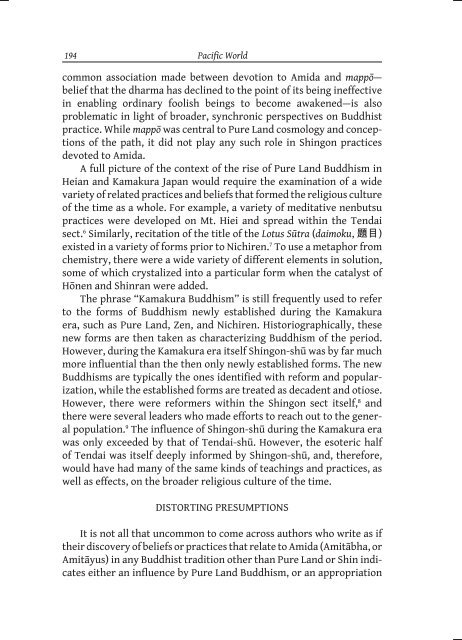The Shingon Subordinating Fire Offering for AmitÄbha, âAmida Kei ...
The Shingon Subordinating Fire Offering for AmitÄbha, âAmida Kei ...
The Shingon Subordinating Fire Offering for AmitÄbha, âAmida Kei ...
Create successful ePaper yourself
Turn your PDF publications into a flip-book with our unique Google optimized e-Paper software.
194<br />
Pacific World<br />
common association made between devotion to Amida and mappō—<br />
belief that the dharma has declined to the point of its being ineffective<br />
in enabling ordinary foolish beings to become awakened—is also<br />
problematic in light of broader, synchronic perspectives on Buddhist<br />
practice. While mappō was central to Pure Land cosmology and conceptions<br />
of the path, it did not play any such role in <strong>Shingon</strong> practices<br />
devoted to Amida.<br />
A full picture of the context of the rise of Pure Land Buddhism in<br />
Heian and Kamakura Japan would require the examination of a wide<br />
variety of related practices and beliefs that <strong>for</strong>med the religious culture<br />
of the time as a whole. For example, a variety of meditative nenbutsu<br />
practices were developed on Mt. Hiei and spread within the Tendai<br />
sect. 6 Similarly, recitation of the title of the Lotus Sūtra (daimoku, 題 目 )<br />
existed in a variety of <strong>for</strong>ms prior to Nichiren. 7 To use a metaphor from<br />
chemistry, there were a wide variety of different elements in solution,<br />
some of which crystalized into a particular <strong>for</strong>m when the catalyst of<br />
Hōnen and Shinran were added.<br />
<strong>The</strong> phrase “Kamakura Buddhism” is still frequently used to refer<br />
to the <strong>for</strong>ms of Buddhism newly established during the Kamakura<br />
era, such as Pure Land, Zen, and Nichiren. Historiographically, these<br />
new <strong>for</strong>ms are then taken as characterizing Buddhism of the period.<br />
However, during the Kamakura era itself <strong>Shingon</strong>-shū was by far much<br />
more influential than the then only newly established <strong>for</strong>ms. <strong>The</strong> new<br />
Buddhisms are typically the ones identified with re<strong>for</strong>m and popularization,<br />
while the established <strong>for</strong>ms are treated as decadent and otiose.<br />
However, there were re<strong>for</strong>mers within the <strong>Shingon</strong> sect itself, 8 and<br />
there were several leaders who made ef<strong>for</strong>ts to reach out to the general<br />
population. 9 <strong>The</strong> influence of <strong>Shingon</strong>-shū during the Kamakura era<br />
was only exceeded by that of Tendai-shū. However, the esoteric half<br />
of Tendai was itself deeply in<strong>for</strong>med by <strong>Shingon</strong>-shū, and, there<strong>for</strong>e,<br />
would have had many of the same kinds of teachings and practices, as<br />
well as effects, on the broader religious culture of the time.<br />
Distorting Presumptions<br />
It is not all that uncommon to come across authors who write as if<br />
their discovery of beliefs or practices that relate to Amida (Amitābha, or<br />
Amitāyus) in any Buddhist tradition other than Pure Land or Shin indicates<br />
either an influence by Pure Land Buddhism, or an appropriation
















